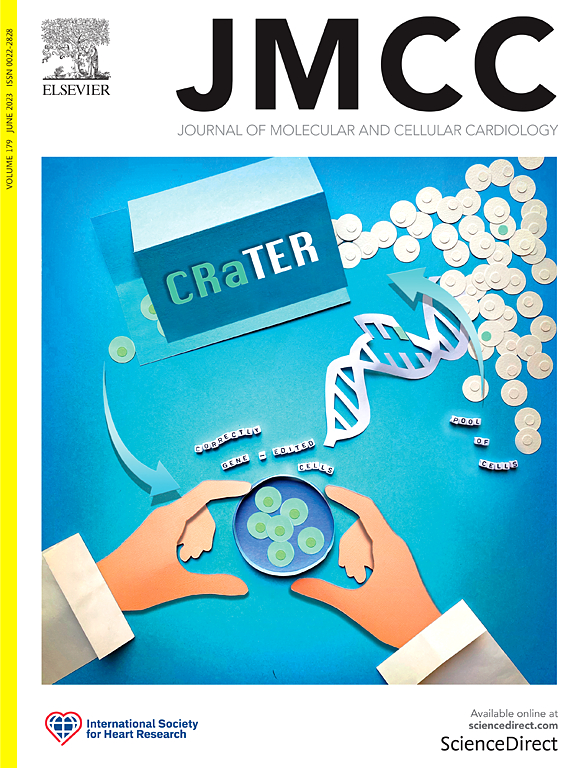Pyruvate kinase splice variants in fibroblasts influence cardiac remodeling after myocardial infarction in male mice
IF 4.7
2区 医学
Q1 CARDIAC & CARDIOVASCULAR SYSTEMS
引用次数: 0
Abstract
Fibroblasts are crucial for cardiac repair after myocardial infarction (MI). In response to signaling cues, they differentiate to phenotypes with robust capacities to synthesize and secrete extracellular matrix (ECM) and signaling molecules. Although activated fibroblast phenotypes are associated with pronounced changes in metabolism, it remains unclear how the metabolic network upholds the effector functions of fibroblasts in the infarcted heart. We found that two enzymes that could facilitate a phosphoenolpyruvate cycle, i.e. pyruvate kinase muscle isoform 2 (PKM2) and phosphoenolpyruvate carboxykinase 2 (PCK2), are elevated in the heart after MI. Although Pck2 deletion had no effect on post-MI remodeling, fibroblast-specific switching of Pkm2 to Pkm1 (fbPkm2 → 1) mitigated ventricular dilation, wall thinning, and losses in ejection fraction caused by MI. Despite these salutary effects, fbPkm2 → 1 switching did not alter cardiac fibrosis in vivo, nor did it affect collagen production, cytokine or chemokine secretion, myofibroblast differentiation markers, or transcriptional regulation in vitro. Nevertheless, Pkm2 → 1 splice variant switching increased myofibroblast contractile activity as well as influenced the metabolic phenotype of fibroblasts, as shown by increased pyruvate kinase activity, higher mitochondrial respiratory capacity, and elevation in glycolytic intermediate abundance. Despite these changes, Pkm2 → 1 switching had relatively minor effects on glucose carbon fate, as determined by stable isotope-resolved metabolomics. Nevertheless, these metabolic data demonstrate that cardiac fibroblasts exhibit minimal glucose-supported de novo glycine synthesis in vitro, yet possess high hexosamine and glucuronate biosynthetic pathway activity. Collectively, these findings reveal that fibroblast PKM isoforms influence post-MI remodeling, highlighting pyruvate kinase as a potential therapeutic target.

成纤维细胞中丙酮酸激酶剪接变异影响雄性小鼠心肌梗死后的心脏重构。
成纤维细胞对心肌梗死(MI)后的心脏修复至关重要。在对信号信号的响应中,它们分化为具有合成和分泌细胞外基质(ECM)和信号分子的强大能力的表型。尽管活化的成纤维细胞表型与代谢的显著变化有关,但代谢网络如何维持梗死心脏成纤维细胞的效应功能仍不清楚。我们发现两种促进磷酸烯醇丙酮酸循环的酶,即丙酮酸激酶肌肉异型2 (PKM2)和磷酸烯醇丙酮酸羧激酶2 (PCK2),在心肌梗死后的心脏中升高。尽管PCK2缺失对心肌梗死后的重塑没有影响,但PKM2向Pkm1 (fbPkm2 → 1)的成纤维细胞特异性转换减轻了心肌梗死引起的心室扩张、壁薄和射血分的损失。fbPkm2 → 1开关在体内不改变心脏纤维化,也不影响胶原生成、细胞因子或趋化因子分泌、肌成纤维细胞分化标志物或体外转录调节。然而,Pkm2 → 1剪接变异开关增加了肌成纤维细胞的收缩活性,并影响了成纤维细胞的代谢表型,如丙酮酸激酶活性增加、线粒体呼吸能力提高和糖酵解中间产物丰度升高所示。尽管有这些变化,Pkm2 → 1开关对葡萄糖碳命运的影响相对较小,这是由稳定的同位素分解代谢组学确定的。然而,这些代谢数据表明,心脏成纤维细胞在体外表现出最低限度的葡萄糖支持的从头合成甘氨酸,但具有高的己糖胺和葡萄糖醛酸生物合成途径活性。总的来说,这些发现表明成纤维细胞PKM异构体影响心肌梗死后的重塑,强调丙酮酸激酶是一个潜在的治疗靶点。
本文章由计算机程序翻译,如有差异,请以英文原文为准。
求助全文
约1分钟内获得全文
求助全文
来源期刊
CiteScore
10.70
自引率
0.00%
发文量
171
审稿时长
42 days
期刊介绍:
The Journal of Molecular and Cellular Cardiology publishes work advancing knowledge of the mechanisms responsible for both normal and diseased cardiovascular function. To this end papers are published in all relevant areas. These include (but are not limited to): structural biology; genetics; proteomics; morphology; stem cells; molecular biology; metabolism; biophysics; bioengineering; computational modeling and systems analysis; electrophysiology; pharmacology and physiology. Papers are encouraged with both basic and translational approaches. The journal is directed not only to basic scientists but also to clinical cardiologists who wish to follow the rapidly advancing frontiers of basic knowledge of the heart and circulation.

 求助内容:
求助内容: 应助结果提醒方式:
应助结果提醒方式:


